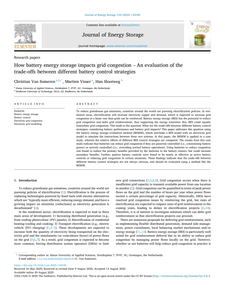To reduce greenhouse gas emissions, countries around the world are pursuing electrification policies. In residential areas, electrification will increase electricity supply and demand, which is expected to increase grid congestion at a faster rate than grids can be reinforced. Battery energy storage (BES) has the potential to reduce grid congestion and defer grid reinforcement, thus supporting the energy transition. But, BES could equally exacerbate grid congestion. This leads to the question: What are the trade-offs between different battery control strategies, considering battery performance and battery grid impacts? This paper addresses this question using the battery energy storage evaluation method (BESEM), which interlinks a BES model with an electricity grid model to simulate the interactions between these two systems. In this paper, the BESEM is applied to a case study, wherein the relative effects of different BES control strategies are compared. The results from this case study indicate that batteries can reduce grid congestion if they are passively controlled (i.e., constraining battery power) or actively controlled (i.e., overriding normal battery operations). Using batteries to reduce congestion was found to reduce the primary benefits provided by the batteries to the battery owners, but could increase secondary benefits. Further, passive battery controls were found to be nearly as effective as active battery controls at reducing grid congestion in certain situations. These findings indicate that the trade-offs between different battery control strategies are not always obvious, and should be evaluated using a method like the BESEM.
DOCUMENT

Passenger flow management is an important issue at many airports around the world. There are high concentrations of passengers arriving and leaving the airport in waves of large volumes in short periods, particularly in big hubs. This might cause congestion in some locations depending on the layout of the terminal building. With a combination of real airport data, as well as synthetic data obtained through an airport simulator, a Long Short-Term Memory Recurrent Neural Network has been implemented to predict the possible trajectories that passengers may travel within the airport depending on user-defined passenger profiles. The aim of this research is to improve passenger flow predictability and situational awareness to make a more efficient use of the airport, that could also positively impact communication with public and private land transport operators.
DOCUMENT

Passenger flow management is an important issue at many airports around the world. There are high concentrations of passengers arriving and leaving the airport in waves of large volumes in short periods, particularly in big hubs. This might cause congestion in some locations depending on the layout of the terminal building. With a combination of real airport data, as well as synthetic data obtained through an airport simulator, a Long Short-Term Memory Recurrent Neural Network has been implemented to predict the possible trajectories that passengers may travel within the airport depending on user-defined passenger profiles. The aim of this research is to improve passenger flow predictability and situational awareness to make a more efficient use of the airport, that could also positively impact communication with public and private land transport operators.
DOCUMENT

An efficient and sustainable logistics process is essential for logistics companies to remain competitive and to manage the dynamic demands and service requirements. Specifically, the first- and last-mile hub-to-hub (inter) logistics is one of the most difficult operations to manage due to low volumes, repetitive operation and short-distance transport, and relatively high waiting times. With the advancements in Industry 4.0 technologies (Internet of Things, Big Data, Cloud computing, Artificial Intelligence), the consortium partners expect that the intelligent and connected technology is a viable solution to improve operational efficiency, coordination, and sustainability of this inter-hub logistics. Despite the promising potential, the impact of technology on inter- and intra-hub (inside hub) logistics operations (such as transportation, communication, and planning) is not well-established. The focus of STEERS is to explore the real-life challenges associated with the logistics operation in a small-to-medium size logistics hub and investigate the potential of intelligent and connected technology to address such challenges. This project will investigate the requirements for the application of automated vehicles in inter-hub transportation and simultaneously explore the potential of intelligent inter-hub corridors. Additionally, inter-hub communications will also provide the opportunity to explore their potential impact on the planning and coordination of intra-hub activities, with an explicit focus on the changing role of human planners. It combines the knowledge of education and research institutes (Hogeschool van Arnhem en Nijmegen, The University of Twente and Hogeschool Rotterdam), logistics industry partners (Bolk Container Transport and Combi Terminal Twente) and public institutes (XL Business Park, Port of Twente and Regio Twente). The insights obtained in this exploratory study will serve as a foundation for the follow-up RAAK-PRO project, in which real-world demonstrators will be developed and tested inside XL Business Park.